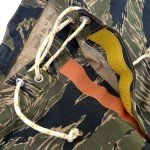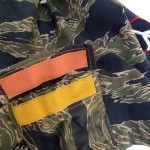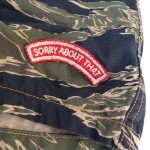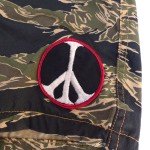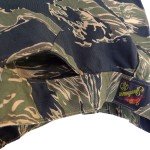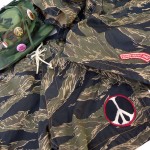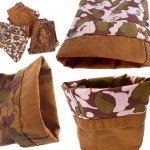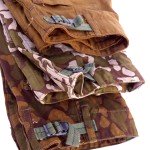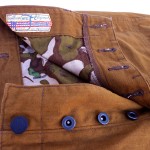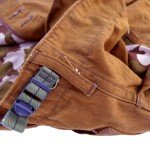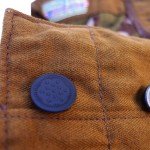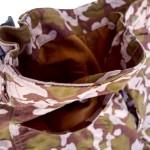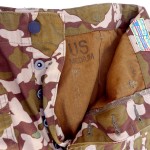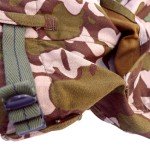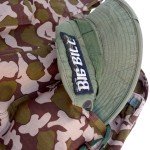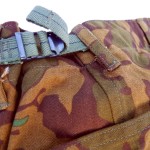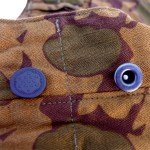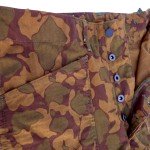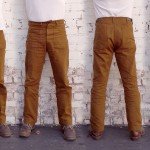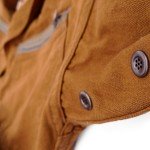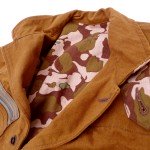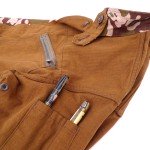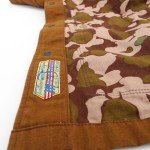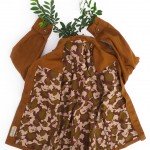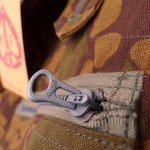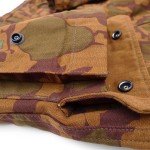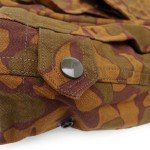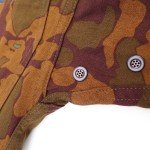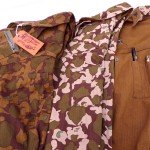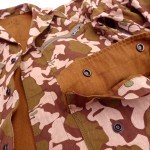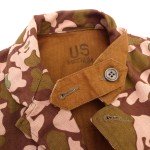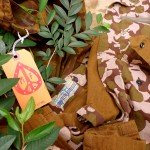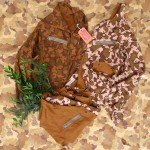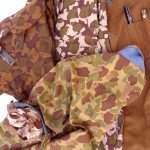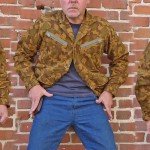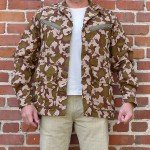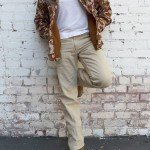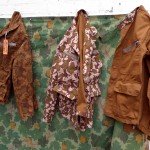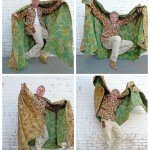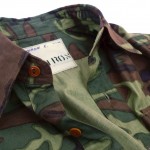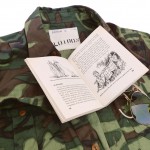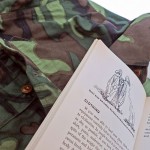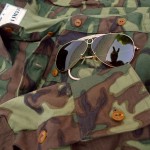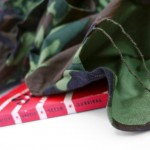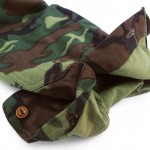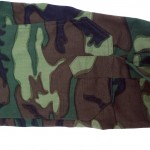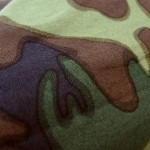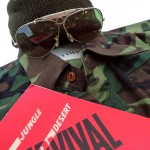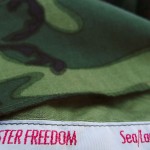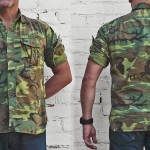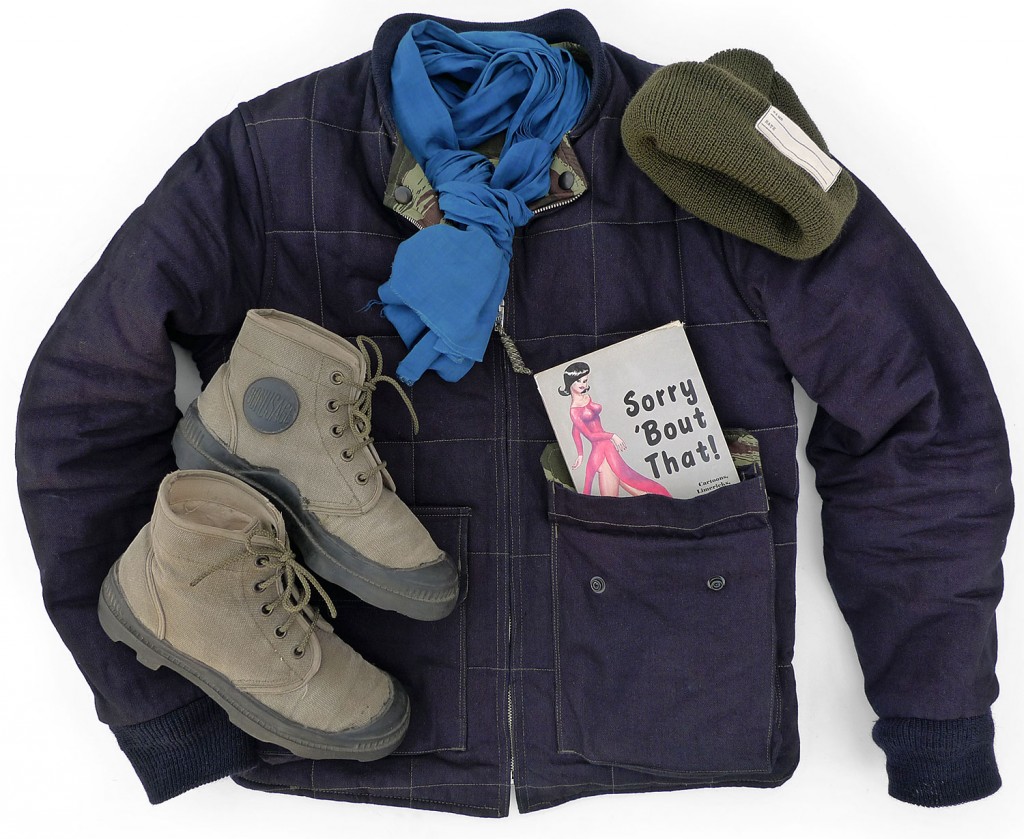
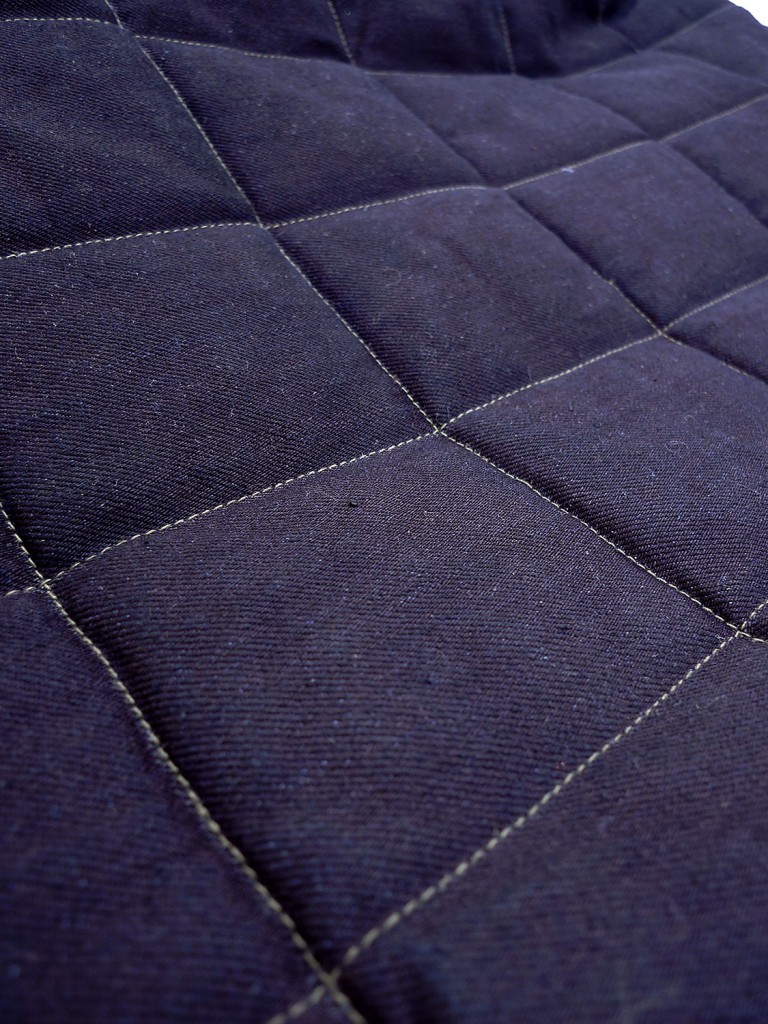 A strong CHANEL influence right here.
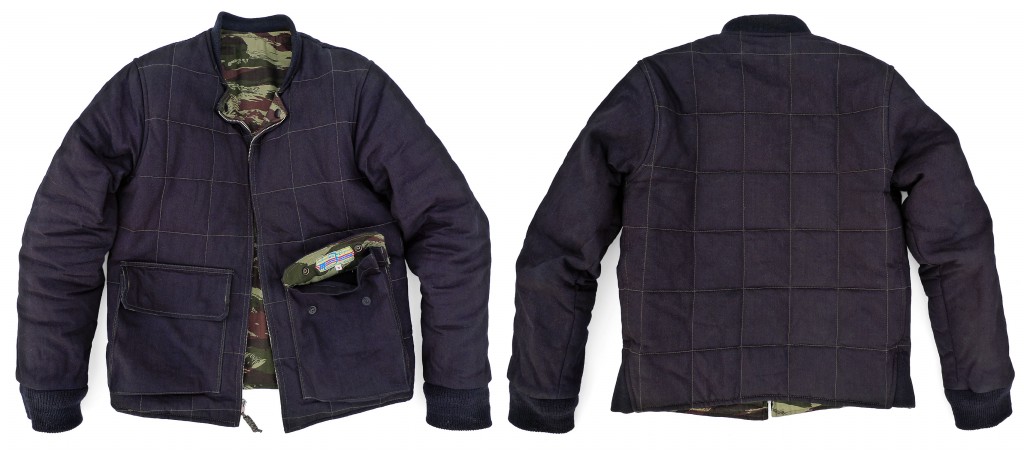
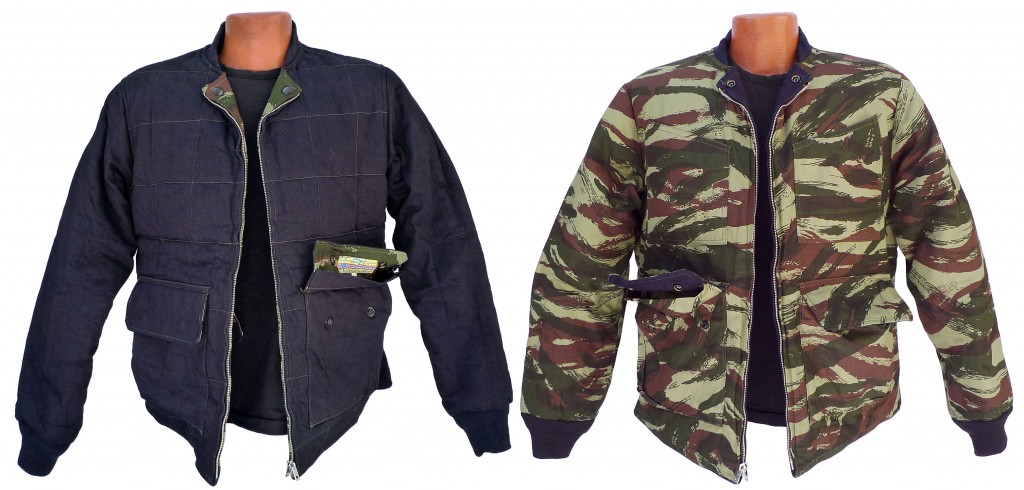
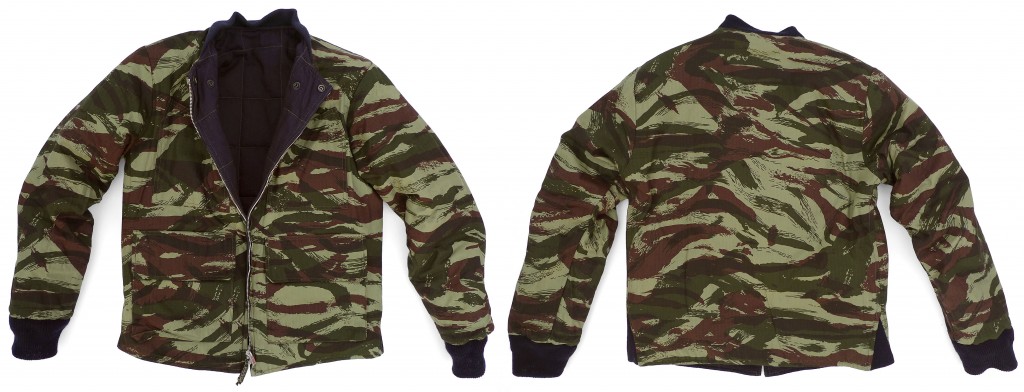
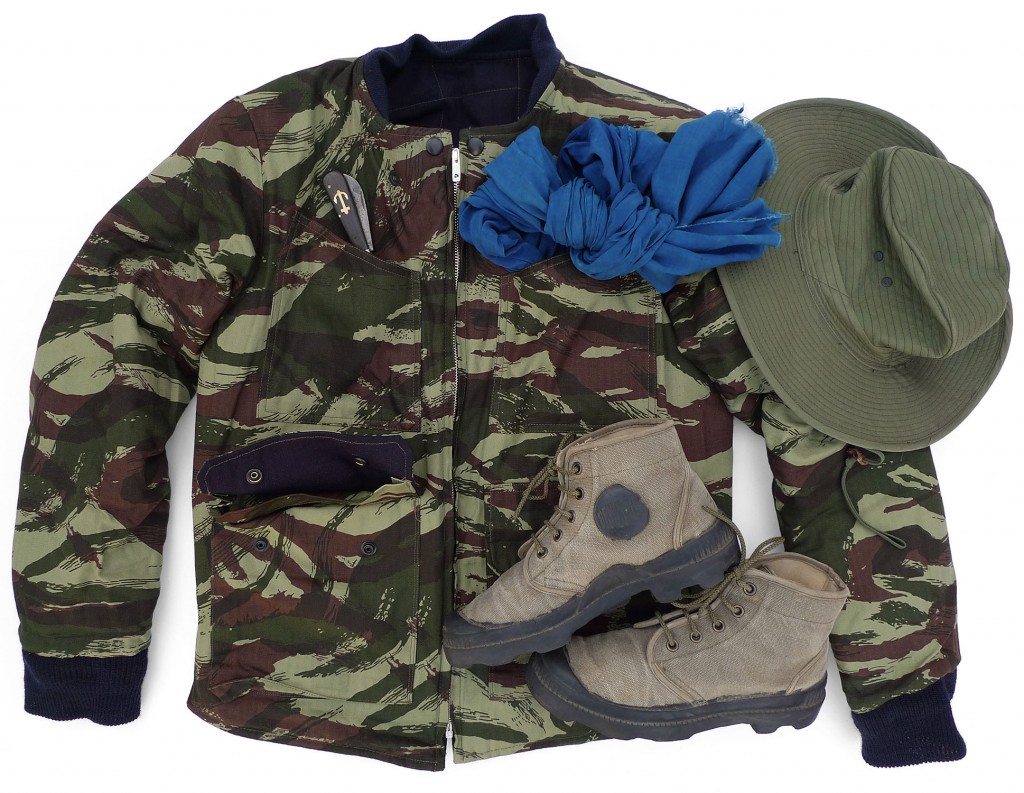
-
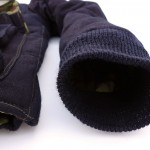
-
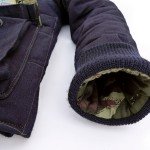
-
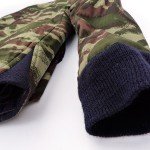
-
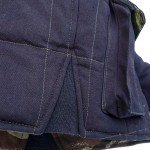
-

-
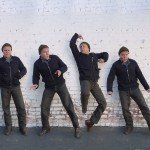
-
Le TAP dance, but of course.
TAP Lézard “Vanden” Jacket, reversible quilted indigo twill x lizard camouflage.
SAIGON COWBOY Fall 2015
Following the release of the Mister Freedom® CDO Jacket, and in a similar Hmongs meets Commando vibe, here is the “Vanden” Jacket. This number will be the final addition to our “Saigon Cowboy” collection, wrapping our Spring and Winter 2015 South East Asia adventure.
Some quick semantics first…
If TAP stands for Troupes Aéroportées (Airborne troops, notorious for their tenue bariolée ‘lézard’), the name “Vanden” is a reference to Roger Vandenberghe. A French military legend, Vanden, as his peers called him, lead the famed Commando N°24 known as the Tigres Noirs (Black Tigers), one of the 45 units making-up the 5,400 men-strong Commando Nord Viet-Nam (1951-1954). Adjudant-Chef ‘Vanden’ would become one of the most decorated non-commissioned officer of the French Army, with most of his decorations earned during the Indochina conflict.
Strategic precursors of the CIA-devised CIDG paramilitary groups that would later take over with the US involvement in Vietnam, these French commando units consisted of men recruited amongst ethnic minorities of mountainous regions of Southeast Asia (Hmong, Nùng… of North Vietnam, Laos). Many defecting Viêt Minh personnel also joined the ranks. For either cultural, economic, ideological or territorial reasons, these Vietnamese nationals volunteered to fight alongside the French colonial troops, against the Ho Chi Minh-lead communists.
Routinely infiltrating enemy-controlled territory, these commandos often opted for uniforms incorporating NVA (North Vietnamese Army) gear, ‘black pajamas’, Chinese military quilted vest, headscarves, dark indigo-dyed garments and other un-conventional local favorites… as can be seen on period photography.
After flirting with death on countless perilous ops, Vanden was to meet his fate in his sleep, assassinated in 1952 by one of his own, a Viêt Minh gone-rogue recruit of the N°24 commando…
For more on that, francophones can refer to “Vandenberghe – Le Commando Des Tigres Noirs – Indochine 1947-1952” by Charles-Henry De Pirey (ISBN:9782914086059).
Photos of Vanden’s Black Tigers courtesy of “PR” on this blog.
Photo of Viet Minh prisoners courtesy of this site.
Photo of night river patrol ©Raoul Coutard, as featured in the book “Guerre Morte” (1954) (ISBN: B00WL1YZIE)
-
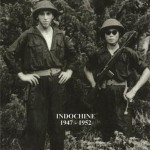
-
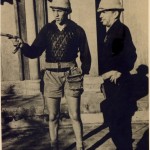
-
Adjudant-chef Roger Vandenberghe Commando N24
-
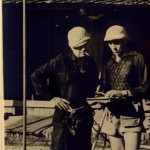
-
Vanden Commando N22
-
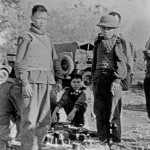
-
Viet Minh prisoners, Chinese quilted vests.
-
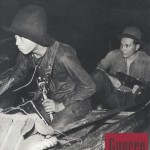
-
Night river patrol, 1950’s Indochina (Photo Raoul Coutard)
-
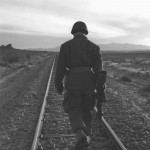
-
4e Regiment d’Infanterie, Algerie, veste matelassée type I
-
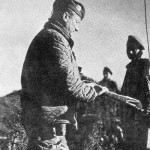
-
LCL Jeanpierre Algerie (1958), veste matelassée type II
Now comes our loose interpretation of all this…
The Mister Freedom® ‘Vanden’ jacket is by no means a replica of authentic Indochina period uniform, but rather a respectful attempt to link History with contemporary wearables, acknowledging a not-so-distant past, lest we forget. This jacket is an original garment that blends vintage aesthetics and references, not an endorsement of bygone imperialistic foreign policies, nor a glamorization of warfare.
The usual MF® spin was put on a 1950’s French Army Type 1 veste matelassée (often seen rolled up atop the rucksack during the French Army Algerian campaign, 1954-1962), an NVA black-dyed vest,… and vintage sportswear field gear. The result is an hybrid jacket featuring double indigo twill on one side, and our version of the traditional camouflage lézard introduced with the Garrison Trousers and Caban Peacoat on the other.
This jacket is fully reversible, featuring a “TYE Tokyo” metal zipper with double-sided pull courtesy of Toyo Tailor, the skilled Sukajan makers of the Mister Freedom® Party Jacket, our special Spring 2015 illiterate keyboard cowboy stimulator.
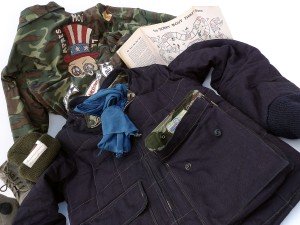 Party Jacket and TAP ‘Vanden’ Jacket The “Vanden” can be worn and zipped-up montagnard side out, or jungle side out. Please note that we left it up too you to customize the pull with your own scoubidou or Paracord tab, as the jacket comes without one.
The “Vanden” features 6 pockets altogether, lower expandable snap flap pockets inspired by French military TAP field jackets, and two camo side chest pockets, quite convenient to store sunglasses or iPhone.
The wool knit cuffs and collar band are mil-specs, courtesy of Buzz Rickson’s.
On a somewhat insignificant note, I have come to like the old stretched-out cuffs of vintage jackets that have been through the wringer, and an easy way to achieve that look is to roll-up the knit cuff on the arm part when the weather permits. Once pulled back down, the cuffs will look ‘sloppily perfect’. This defeats the purpose of keeping the wrist section air-tight, triggering the usual slave-to-style issue, be cool or stay warm, for those of us blessed with such First World dilemmas.
The bottom of the jacket features side expansion wool knit gussets, a vintage-inspired detail we already used on the Chiller Vest, an old Mister Freedom® garment from our 2010 “Speed Safe” collection. This features comes handy when the jacket is fully zipped-up and you are at the wheel.
For the inner padding, we opted for a 100% polyester fiber thermal fill, great for warmth but not too bulky to avoid the Michelin Man look. The square-shape quilted pattern is only featured on the indigo side of the body. The arms are not quilted but still feature a thin thermal padding.
The TAP Lézard ‘Vanden’ Jacket is designed in California by Mister Freedom® and manufactured in Japan by Sugar Cane Co.
SPECS:
FABRIC:
Montagnard side: “Double indigo twill”, a very dark (almost black) indigo warp and indigo weft 100% cotton denim twill, 12.4 Oz., white selvedge ID. Milled in Japan.
Jungle side: 100% cotton HBT ‘lizard’ camouflage fabric, milled and printed in Japan.
Inner padding: 100% polyester fiber thermal fill.
DETAILS:
* Inspired by 1950’s Indochina War military gear and vintage outdoor garments.
* Fully reversible.
* 4 bottom expanding pockets with snap flap, with two extra chest pockets on the lizard side.
* 1950’s sukajan style reversible “TYE Tokyo” metal zipper with double pull tabs.
* 100% polyester fiber filling with minimal ‘puffiness’.
* Mil-specs wool knit cuffs, collar band and side expansion gussets.
* Square-shape quilting pattern on the indigo side.
* Olive green 100% cotton thread.
* Snap down collar lapels.
* Concealed woven Saigon Cowboy label stitched inside pocket flap.
* Made in Japan.
SIZING/FIT:
The “Vanden” Jacket comes raw/unwashed and we recommend an initial cold soak (~30mn) with occasional hand-agitation to insure total immersion. Spin cycle and line dry. This jacket is quite bulky and heavy when wet, so do not attempt a full washing cycle as this might damage both your jacket and your washing machine.
This jacket is true to size, and a Medium (38) fits like a snug Medium by mfsc standards. I wear a Medium with enough room for a sweatshirt or denim jacket underneath. This is a rather fitted jacket, depending of course on your build, proportions and choice of size.

Please refer to sizing chart for cold rinse/line dry approximate measurements.
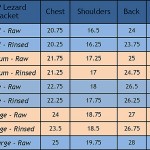
CARE:
Launder when hygiene dictates and common sense prevails.
We recommend professional cleaning in your local eco-friendly facility. If not practical, hand wash or machine wash on DELICATE in large capacity washer to avoid damaging both jacket and machine. Cold water, delicate cycle, eco-friendly mild detergent and line dry. We recommend turning indigo blue/denim garments inside out to avoid marbling when washing. Un-zip jacket before washing.
Patina will develop according to activities and frequency of wear.
WARNING: The double indigo twill will naturally bleed, and minimal color transfer to light color garments or furniture is to be expected. Indigo transfer will wash-off overtime.
Available RAW/unwashed
SIZES:
Small (36)
Medium (38)
Large (40)
X-Large (42)
XX-Large (44)
RETAIL $699.95
Soon available from www.misterfreedom.com, fine retailers around the World, and our Los Angeles brick & mortar store.
Email sales@misterfreedom.com or call 323-653-2014 with any questions unanswered above.
Thank you for reading and for your support,
Christophe Loiron
Mister Freedom® 2015
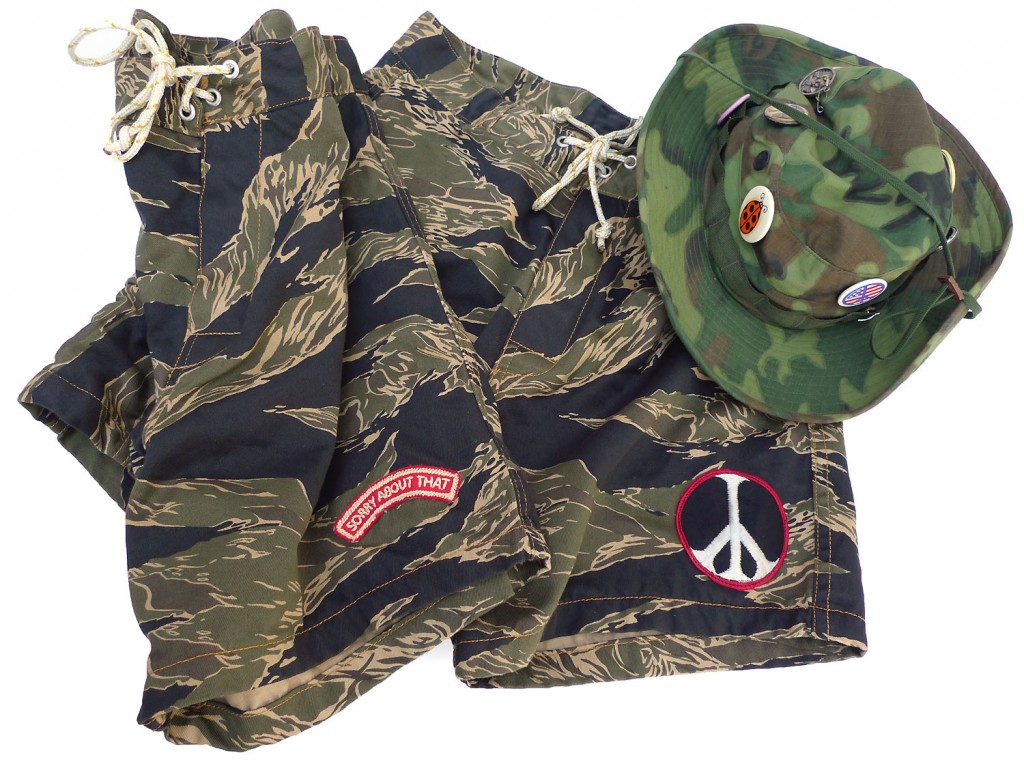

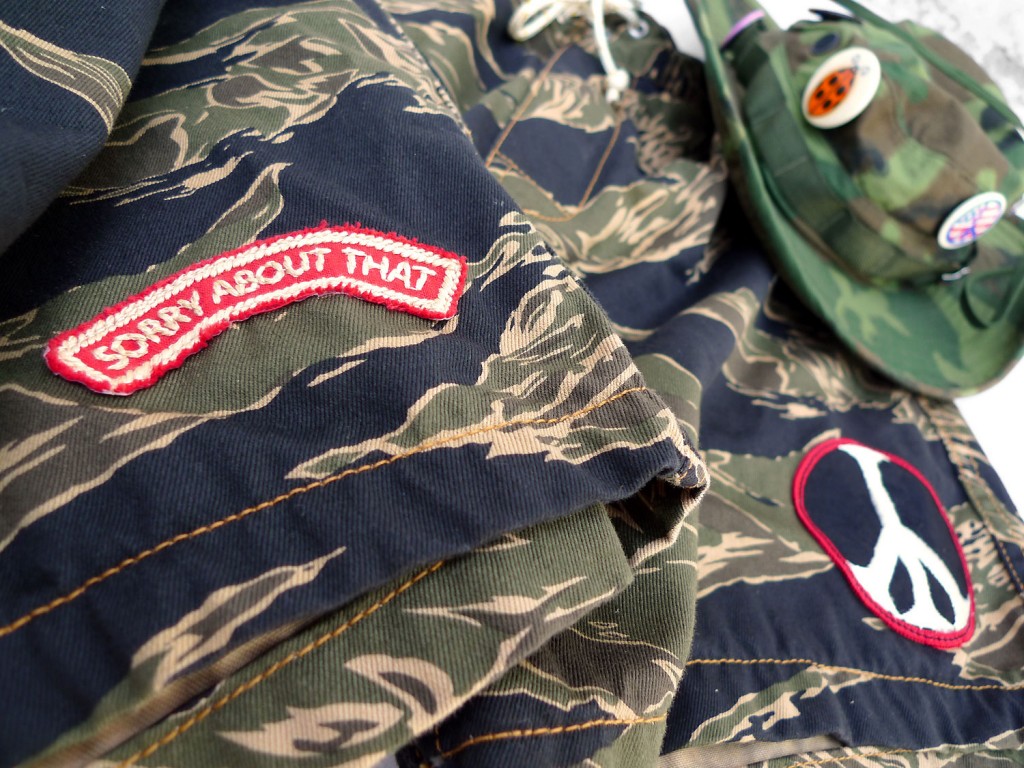
Tiger Board Shorts
“Saigon Cowboy” mfsc Spring 2015
“Mad Mark was the platoon leader, a first lieutenant and a Green Beret. (…) His attitude and manner were those of a CIA operative. A lover of stealth. A pro, a hired hand. (…) He wore tiger fatigues, not for their camouflage but for their look.”
Excerpt from ‘If I Die in a Combat Zone: Box Me Up and Ship Me Home’ Tim O’Brien (1975)
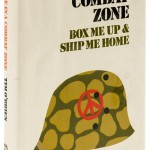 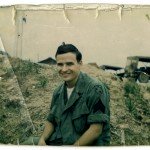
While Camp Pendleton Marines were chasing SoCal surfers out of Trestles, a few selected men of the Green Machine were board-riding the South China Sea waters of war-torn Vietnam. There it is.
Because eeeeverybody’s gone suuuurfin’, surfin’ USA in the 1960’s, the draft was to inevitably send some wave-obsessed kids to Vietnam. If Colonel Kilgore was a fictional character, several real life accounts testify of that. A certain Private Wyatt Miller Jr even managed to technically go MIA, last seen wiping out off Da Nang, on September 13, 1970…
Quite an interesting documentary, the 2008 film “Between The Lines: The True Story of Surfers and the Vietnam War” depicts the contrasting perspectives of combat vet surfer Pat Farley and surfer-dodger Brant Page, amongst others. Of hang tens and M-16s. Not a ton of period footage for obvious reasons, but insightful raw interviews nonetheless, not exactly highlighting the sanity of the Human race…
-

-
Marine confiscating board (1969) Photo Ron Stoner Courtesy SURFER
-
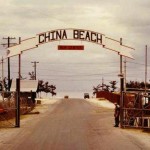
-
China Beach MP main gate
-
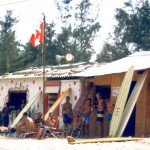
-
China Beach Surf Club, Vietnam, (1968) Photo Dennis Norton
-
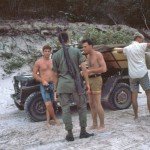
-
“Between The Lines”, Photo Greg Samp collection
-
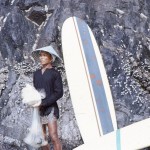
-
“Between The Lines”, Photo Tom Woods collection
-
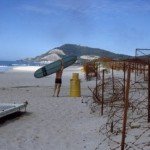
-
Vung Tau beach (1968) Photo Kerry Seebohm
-
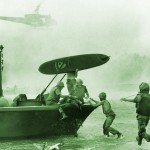
-
Colonel Kilgore’s board (Apocalpyse Now, 1979)
-
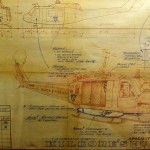
-
Kilgore’s chopper. Courtesy The Surfer’s Journal
To accompany our “Saigon Cowboy” in his endless summer safari, we are issuing a tiger stripe edition of the Board Shorts, a model we originally introduced for Spring 2014. These Mister Freedom® board shorts are inspired by several classic pairs of late 60’s~70’s trunks (Hang Ten, etc…), and feature an adjustable waist closure, Velcro® tape fly, side pocket, concealed rear pocket…
We scored some yardage of gold tiger stripe camouflage from our friends at Buzz Rickson’s. I believe this specific tiger pattern is referred to as TSP (Tadpole Sparse Pattern), but I’m probably wrong on that. The correct answer should be inside Richard Denis Johnson’s “Tiger Patterns” (ISBN 0-7643-0756-8).
For the salty look, we ‘partied-up’ our board shorts in two options, each featuring a single patch:
a) Reproduction “Sorry About That” red arc patch, with a local hand-made look.
b) Original 1970’s New Old Stock “Peace sign” patch.
Those inclined to do so will find many other vintage patches out there to spice this up, or a seam ripper to remove them. The older type machine-made patches are soft and have a cotton gaze-like back. They look much better in my opinion than the modern, rigid, iron-on kind found everywhere. Many eBay dealers offer reproduction or original patches from the Vietnam era.
I personally opted for three patches on my trunks, to take on bust-a-twig patrol while doing the jungle cancan.
-
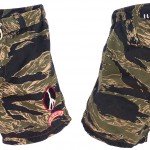
-
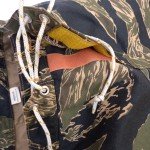
-
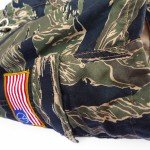
-
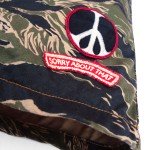
-
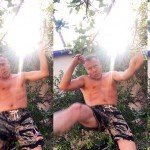
-
bust-a-twig patrol
-
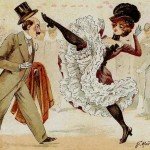
-
lala lalalalala la…
The Tiger Board Shorts are designed and manufactured in California by Mister Freedom®, in collaboration with Sugar Cane Co.
SPECS
FABRIC:
Buzz Rickson’s 100% cotton twill, printed with TSP (Tadpole Sparse Pattern) gold tiger stripe camouflage. Made in Japan.
DETAILS:
* Late 60’s to 1970’s style
* Paracord/eyelet waist closure system.
* Velcro® fly closure.
* Reproduction or NOS patch customization.
* Side pocket with Velcro® closure flap.
* Rear concealed sand pocket.
* Orange poly-cotton contrast stitching.
* Made in USA.
SIZING/FIT
The board shorts are only available RAW.
The tiger board shorts will shrink to tagged size. The way the waistband closure is designed allows for a 1-1½ inch play, according to how tightly pulled the paracord is.
Please refer to sizing chart for soak/line dry measurements (please note that further shrinkage can be expected with hot soak and machine dry.)
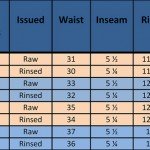
CARE:
Low maintenance, machine wash when needed. Color fading to be expected overtime.
Available Raw (unwashed) ONLY
Tagged Sizes
X-SMALL (approx W28)
SMALL (approx W30)
MEDIUM (approx W32)
LARGE (approx W34)
XLARGE (approx W36)
Retail $149.95
Available from www.misterfreedom.com, fine retailers around the World, and our dusty Los Angeles brick & mortar store.
Email sales@misterfreedom.com or call 323-653-2014 with any questions unanswered above.
Thank you for your support.
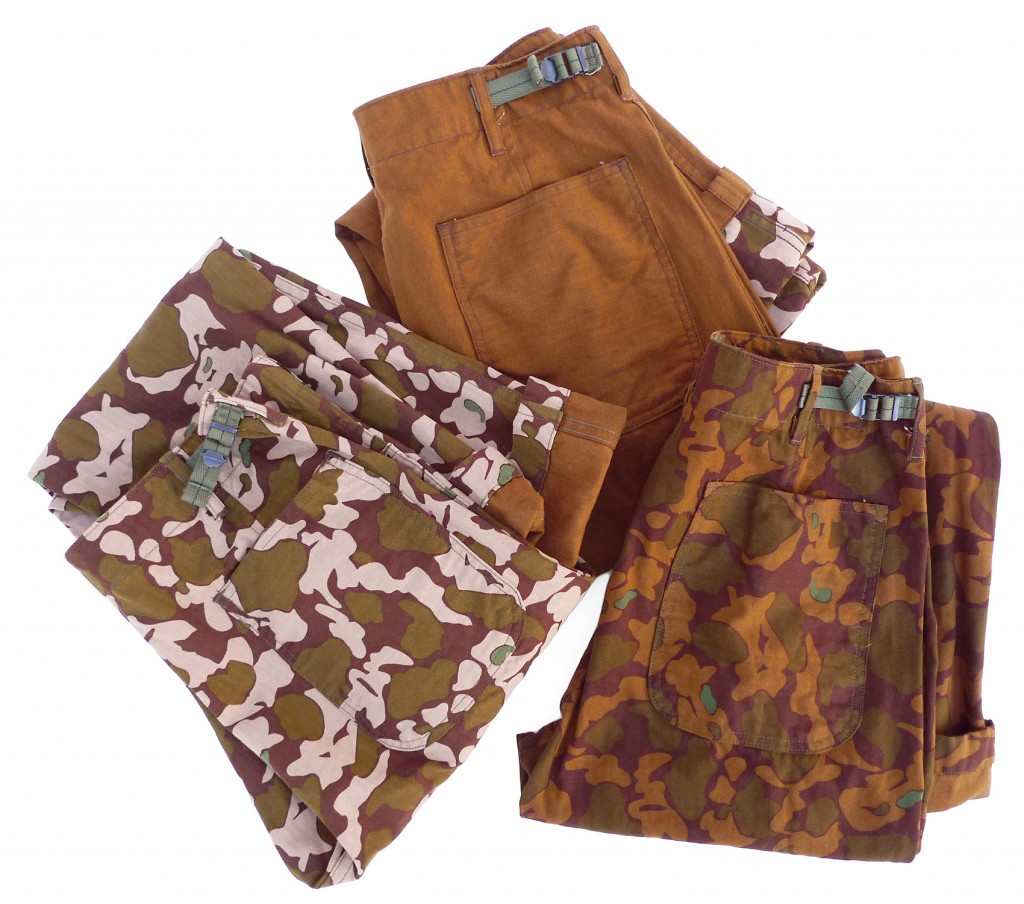
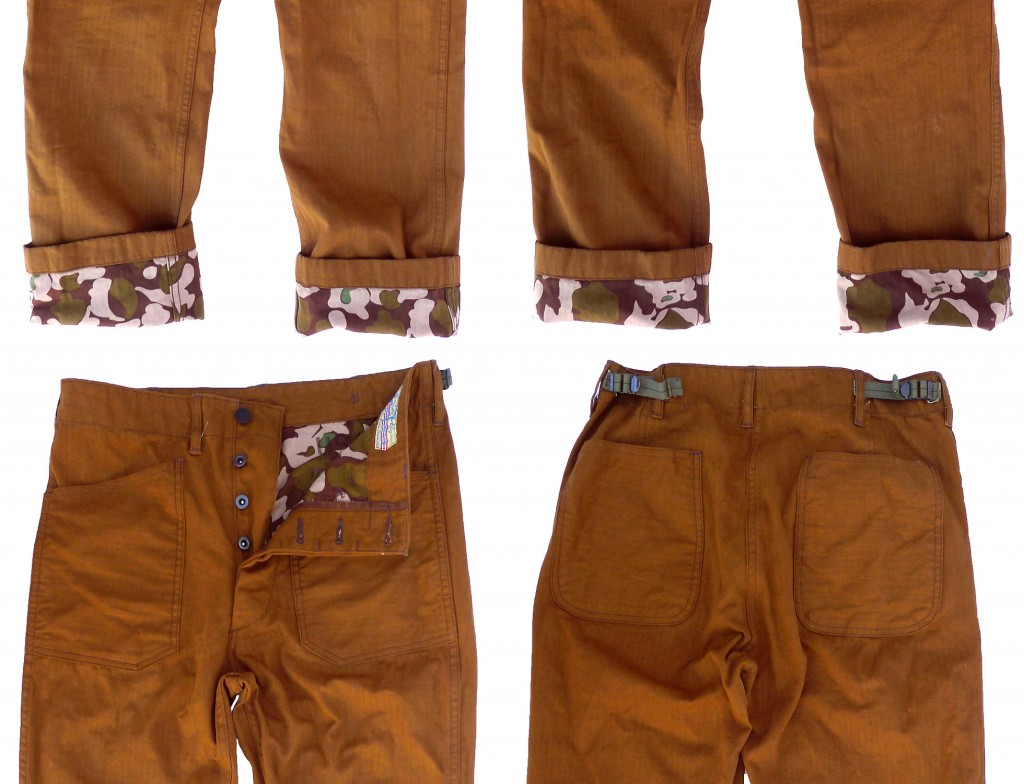 Utes Cachou.
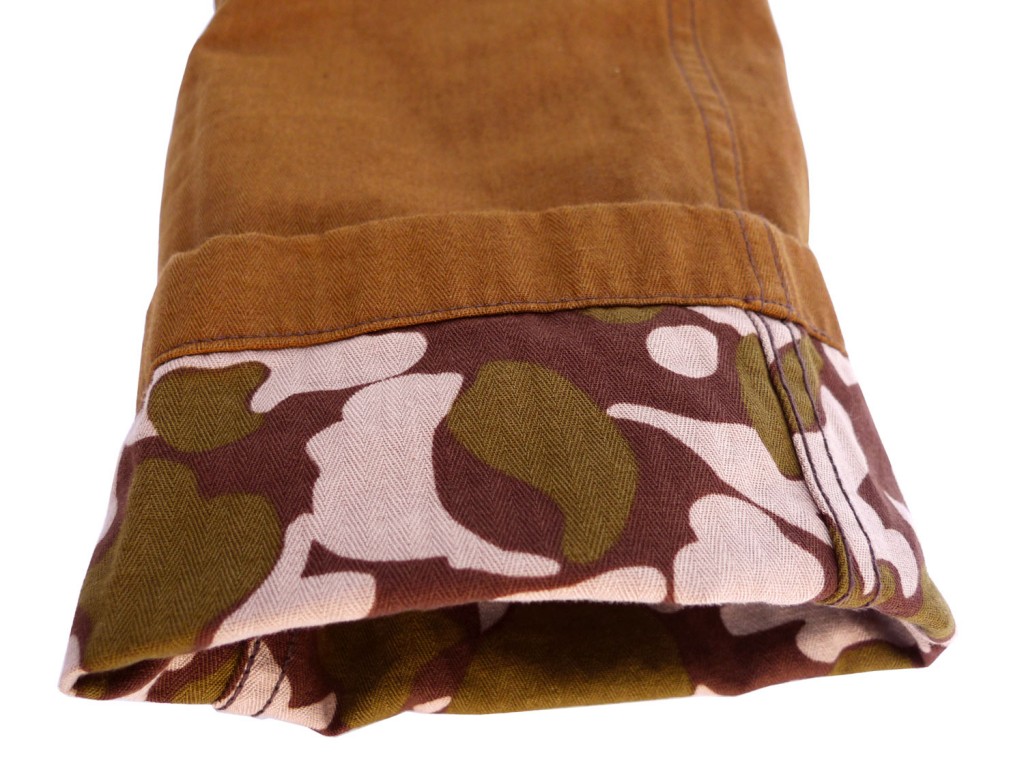
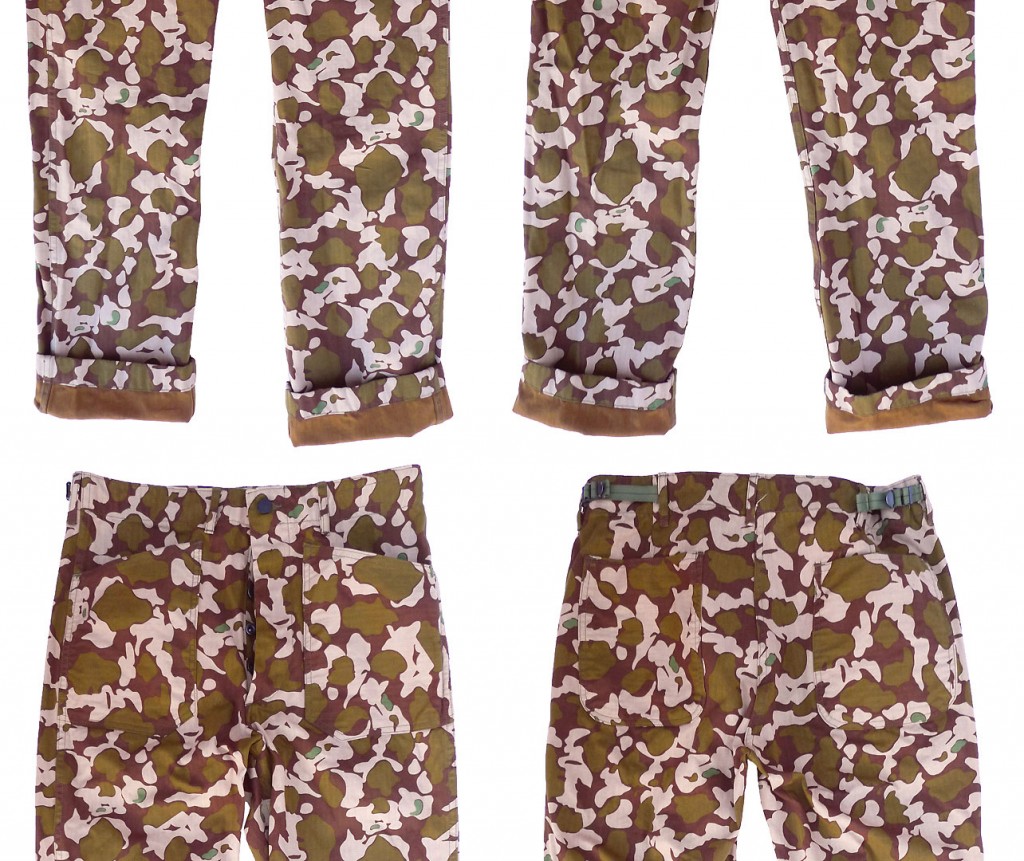 Utes Hiland.

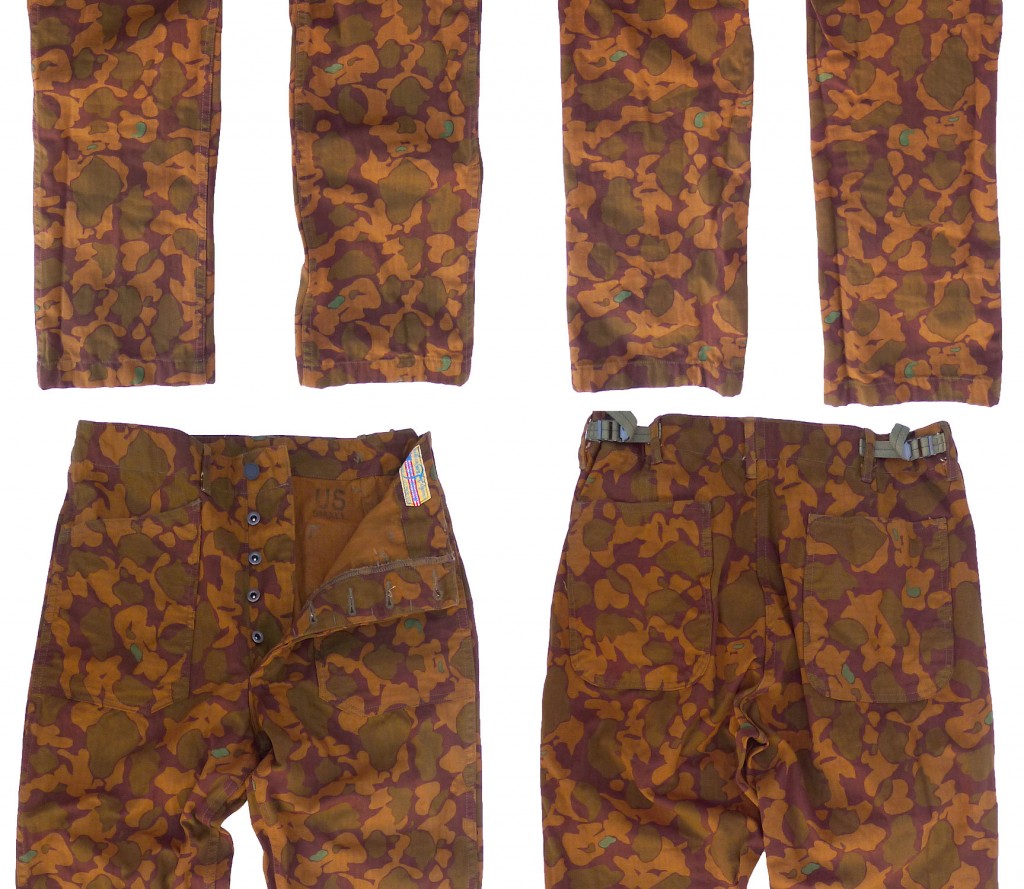 Utes Loland.
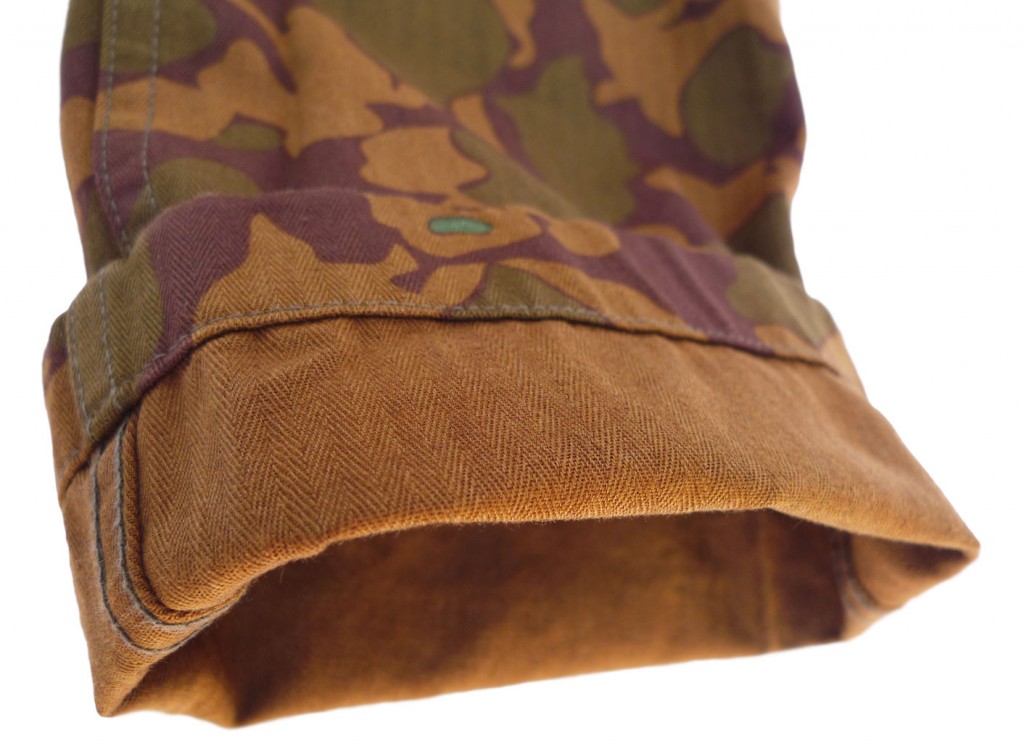
Utility Trousers, “Utes” Experimental Camouflage
Mister Freedom® “Saigon Cowboy” Spring 2015
For those into the jungle tuxedo, our MF® Experimental Camo is now available in fine looking trousers as well! For those lucky to have missed it, the account of how our original camouflage pattern came to be was summed up in the Evac Jak spiel.
For today’s story, who needs fiction when you have CIA declassified intel? Here is some of it, revisited…
The year is 1961.
American taxpayers have been unknowingly forking over $400 million to the French imperialist war effort in Indochina from 1945 to 1954 (thereby funding about 80% of the French Guerre d’Indochine), but we are still four years short of the ‘official’ engagement of the United States in Vietnam’s affairs of 1965.
In those years, some felt that if you didn’t stop the red devils (‘commies’) in the jungles of South East Asia, “they would have to be stopped in Honolulu or on the beaches of California.”
President Kennedy, a man of his times and a believer in the efficiency of US Special Forces guerilla tactics, sends 400 tiger stripes-clad intensively trained men to the highlands of South Vietnam in May 1961, in an effort to contain the spread of the National Liberation Front (NLF), China’s protégé…
Men in green berets immerse in the local culture, assess the situation and organize local resistance. Montagnards and local villagers receive training in jungle warfare. The enemy du jour? The Việt Cộng (Vietnamese Communists) guerrillas, VC (NATO’s Victor Charlie), or Charlie as often referred to by US boots on the ground.
A program called CIDG (Civilian Irregular Defense Group) and originally designed by the CIA has the task to assist in the transformation of local minorities into anti-communist paramilitary forces.
To more efficiently handle logistics, the highly-classified Counter Insurgency Support Office is established on the island of Okinawa, Japan in 1963. Headed by a mysterious individual working for the Department of Army by the name of Conrad Benjamin Baker, CISO was “assigned the mission of supporting the Special Forces programs through triservice depots and local procurement sources (…) Many items of clothing and equipment, for example, had to be obtained from markets in other countries because of size problems, composition of material, and equipment which had to be tailored to Montagnard measurements.” (source)
CISO acquired or produced ‘sterile’ (untraceable if captured) weapons, along with unmarked clothing and equipment to outfit US Special Forces or advisors heading out to South Vietnam. Locally screen-printed tiger stripe camo fatigues, “bowie” knives, VC-style black pajamas, rations, machetes, Seiko watches for recon teams, black 1-0 rain jackets, North Vietnamese Army-inspired rucksacks…
Basically, if it proved needed in the field, CISO sourced it out in Asia, or designed it and manufactured it locally. At a fraction of the price compared to US-made mil-specs issued gear, and quicker delivery than its state-side bureaucracy-laden official channel alternative. What exactly went on is not well documented, but Ben Baker’s account of his involvement in the original design and R&D of the famous SOG knife is available for download in pdf form here.
Note:
I am no expert on the topic and more accurate facts are available to those interested in History preservation willing to do the research. The “SOG” book by John L. Plaster probably answers many questions, but I admit having only flipped through its photo album companion (ISBN 1-58160-058-5) due to time restriction.
-
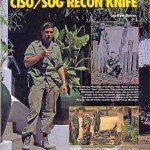
-
Courtesy of “Fighting Knives” magazine (1991)
-

-
1-0 CISO Jacket (Courtesy Jim Brzozkiewicz)
-

-
3rd Force Recon Patrol (Courtesy Doc Cassidy)
-
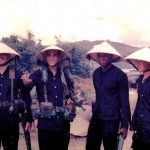
-
LRRPS (Photo Albert R. Brown 1968) Courtesy www.lrrpranger.org/
-

-
Montagnard in training (1962)
-
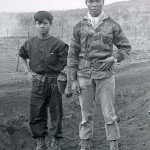
-
Montagnard Civilian Irregular Defense Group force attached to Company D MIKE-FORCE in the Dak To SF Camp fire-base
-
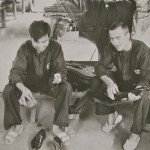
-
Special Forces Lt. Rich Entlich (1966) Courtesy Charlotte Sun newspaper
-
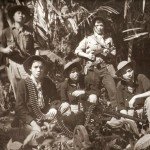
-
VC Guerrillas South Vietnam (1968)
-
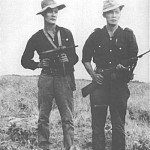
-
The feared “Men in black pajamas” (NVA photo 1968)
(Above photos credited to the best of our knowledge and provided for educational purposes only.)
I had found the logistics side of this CISO story quite fascinating when originally coming across it. As usual, we didn’t take any of this literally in our ‘Saigon Cowboy‘ venture. Imagination took over authenticity. We didn’t go black pajamas, decided to improvise instead, mixing things up into a somewhat plausible garment. Or maybe our ‘utes’ are just a pretext for sharing a slice of ‘behind-the-scene’ History…
The pattern for the featured MF® trousers this season blends details of US Navy dungarees, Army chino trousers, M-51 field trousers, Marine Corps M1941 trousers… a joint operation if you will.
The term ‘utes’ was lifted from the old USMC expression “boots ‘n’ utes” (boots and utility uniform).
As mentioned with the Evac Jak, the MF® Exp. camo combines camouflage with a simple solid side. The solid side cachou color is a reference to the caramel-like color typical of 1930’s French military canvas gear. Although this fabric is designed to be reversible, the trousers are not. Three options are available for the Exp camo utilities:
a) Cachou out/HiLand in.
b) HiLand out (arid terrain, lighter)/cachou in.
c) LoLand out (jungle, darker)/cachou in.
The sizing S,M,L,XL applied to trousers is a nod to old military field pants featuring cinch tabs. Those are often tagged with a ‘size range’ as opposed to a precise measurement, reflecting the waist-adjusting pull tabs.
The “US” stamp stands for sizing following American standards, as opposed to the “A” stamp differentiating Asian standards garments with CISO-issued gear.
Our ‘utes’ have a slimmer silhouette than typical standard-issue cargo pocket camo utilities, a reference to a silhouette favored by ARVN troops of the period.
The “Utes” are designed in California by Mister Freedom® and manufactured in Japan by Sugar Cane Co.
SPECS
FABRIC:
Somewhat of an original Mister Freedom® camo pattern, double-side rotary screen printed (one side solid, one side camo), white 100% cotton Herringbone Twill (HBT) fabric base.
Fabric milled and printed in Japan.
DETAILS:
* Inspired by vintage military utility trousers.
* Slimmer ‘ARVN’-type silhouette.
* Mid-high waisted.
* Front patch pockets locked in side seam, rear patch pockets, horizontal HBT.
* Side cinch tabs, mil-spec slide buckle.
* Flat black-painted Metal “13 Stars” tack waist button.
* Oxidized black donut-type fly buttons.
* Flat felled seams, chainstitch.
* 100% cotton tonal stitching.
* Made in Japan.
SIZING/FIT
This garment comes raw/unwashed and will shrink to tagged size after an original cold soak/line dry. Further shrinkage to be expected with the use of hot water and heat dryer.
All three MF® Exp. Camo fabric options will shrink the same.
I decided to size down in those, as I had done with the Crew Pants of the Sea Hunt spring 2013 collection, and I am wearing a Small (30). When both fully cinched, the waist tabs can tighten the fit by about 2 inches, but a Medium looked too baggy on me. A tagged Small technically corresponds to a 30-32 inch waist.
Please refer to sizing chart for measurements reflecting a 30mn cold soak no agitation/light machine dry.
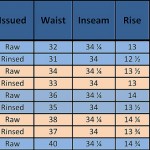
CARE:
Launder when hygiene dictates and common sense prevails.
Machine wash. Cold water, gentle cycle, eco-friendly mild detergent and line dry. We recommend turning garments inside out to avoid marbling of the fabric during the washing cycles.
Because the base HBT fabric is white before being printed, toning down of colors will naturally occur. This fading should not be considered a quest nor a defect, only the natural consequence of the wash/wear process over the years.
Available RAW/unwashed
SIZES:
Small (30)
Medium (32)
Large (34)
X-Large (36)
XX-Large (38)
RETAIL $229.95
Available from www.misterfreedom.com, fine retailers around the World, and our dusty Los Angeles brick & mortar store.
Email sales@misterfreedom.com or call 323-653-2014 with any questions unanswered above.
Thank you for your support
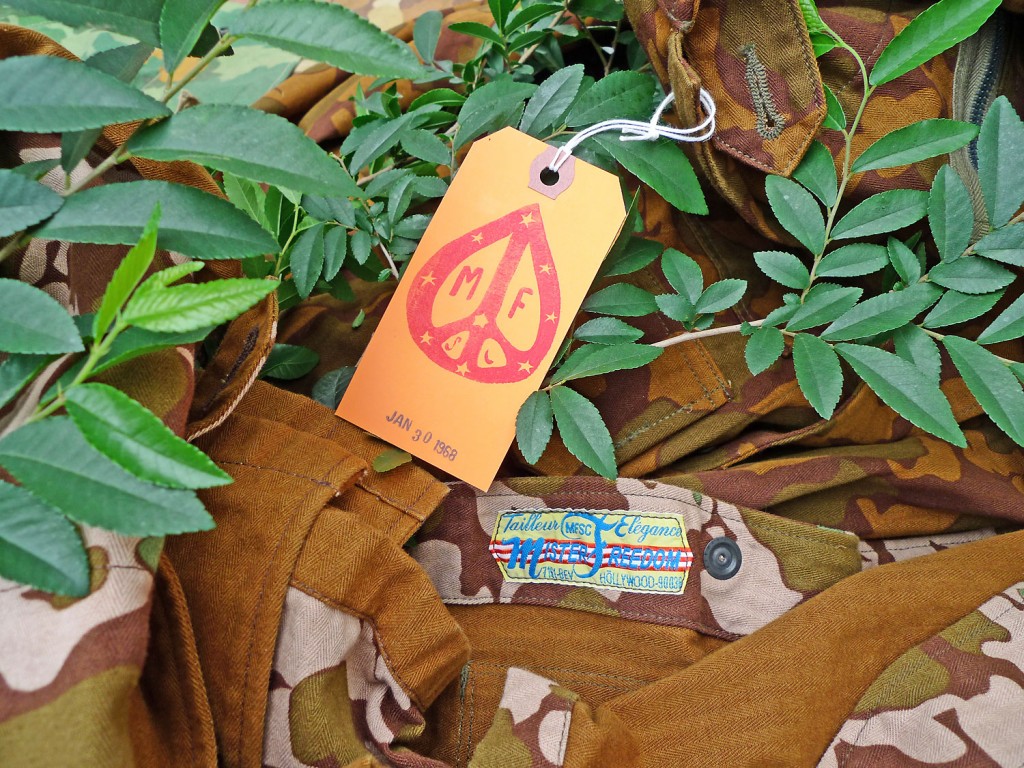
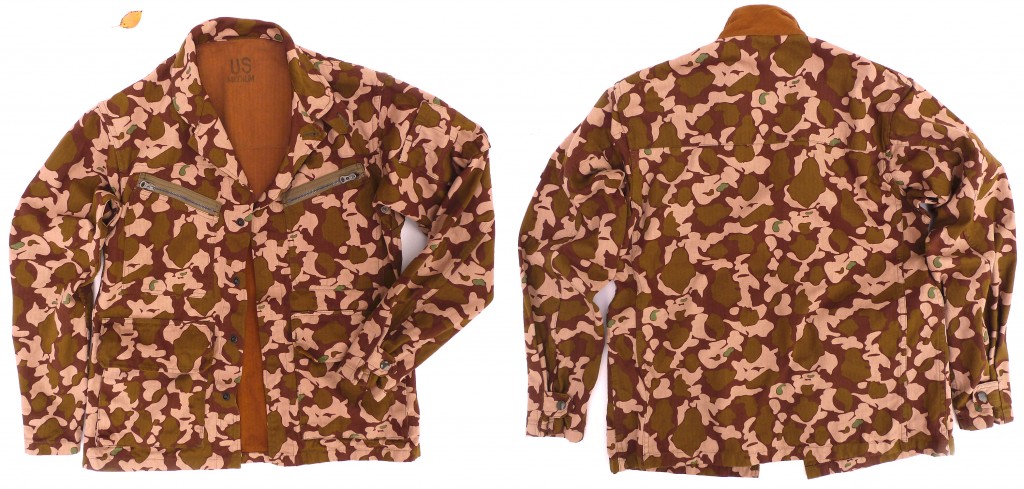
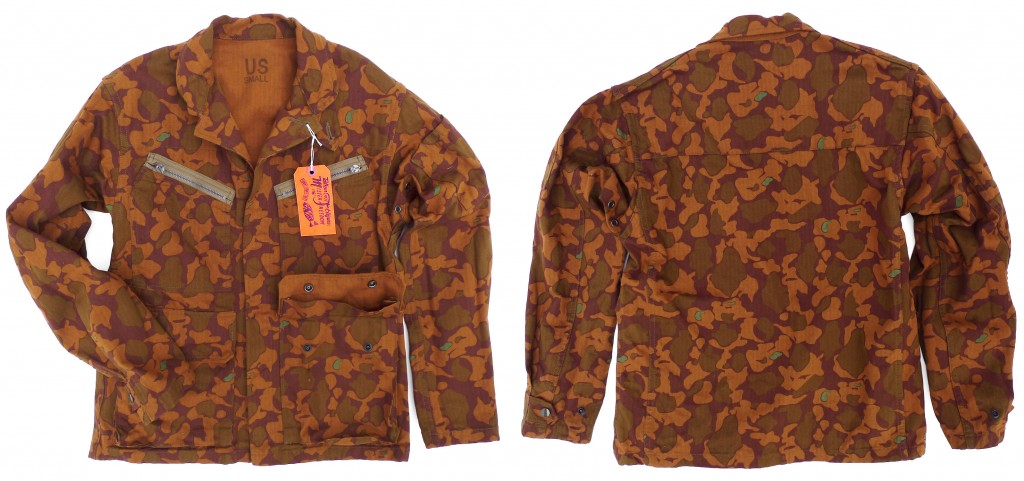 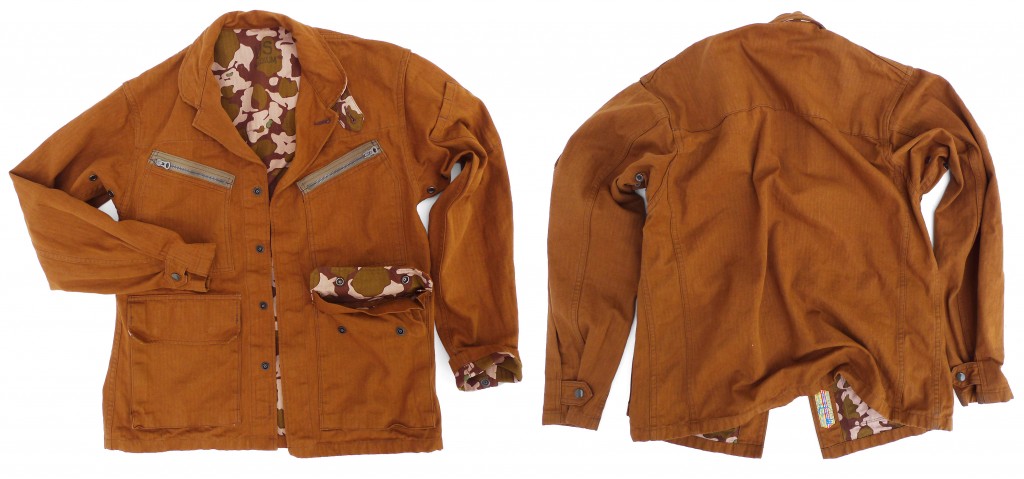
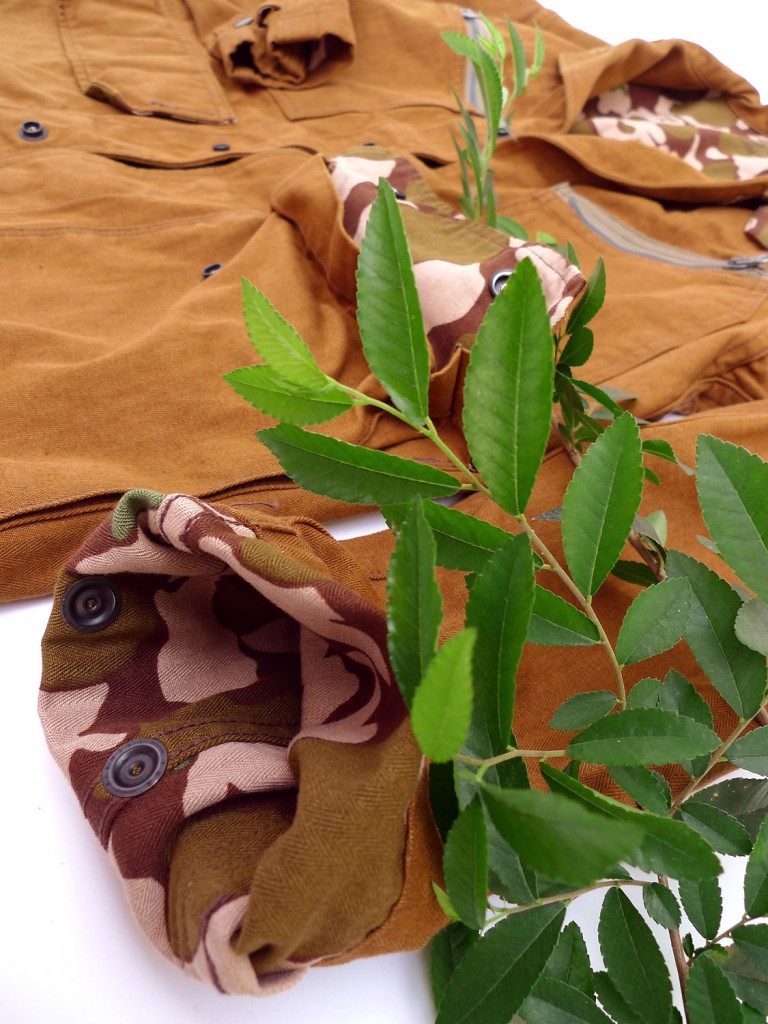
Evac Jak, Experimental Camouflage
Mister Freedom® “Saigon Cowboy” Spring 2015
After an Homeric attempt at an introduction of both our intentions and the background of our Spring 2015 “Saigon Cowboy” concept collection, here comes the time to actually unleash its first chapter. Straight off the steamy jungles where the panthera tigris, majestic beast of the night, roamed free. Until…
…whomp-whomp-whomp-WHOMP-WHOMP-WHOMP…
(skies fill with green UH-1s above the canopy, “Ride Of The Valkyries” plays)
It’s show time… sit back and cringe.
It is a documented ancient tradition for warriors to adorn themselves with the furry hides of ferocious hunted creatures, in order to appropriate and hog specific powers from the animal kingdom.
This practice seems to have extended to modern warriors by way of printed cloth known as camo. From the leopard-print cowboy hats of some US advisors in Vietnam to the flashy cheetah-print fatigues of the General Mobutu’s Armed Forces of Zaire in the 1970’s, it can be said that there is no end to human creativity in the concealment business.
To quote the New York Times in a camouflage-related piece back in 1917, “It is a wonderful opportunity, this game of hokus-pokus“.
Nothing spells human ingenuity like painted zebra stripes on a donkey or battleship to fool the enemy.
-
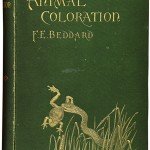
-
Animal Coloration, Frank Evers (1892)
-
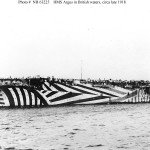
-
Dazzle camo HMS Argus (1918)
-
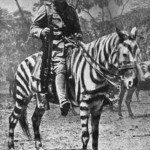
-
Camo pony, British Cavalry WW1 East Africa
-
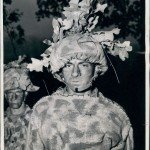
-
Hessian Frogskin (1943?)
-
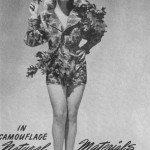
-
Chili Williams (1943) Ewing Krainin
-
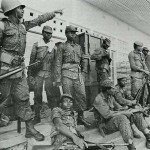
-
Armed Forces of Zaire camouflage (1977)
-
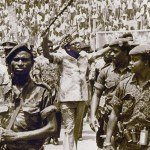
-
Mobutu (1974) Cheetah camo
-
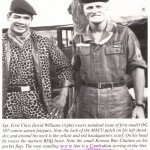
-
Leopard Camo (1964) David Williams. Courtesy Paul W. Miraldi, Schiffer Books
-
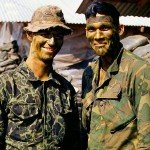
-
101st Airborne ROK and ERDL camo (1969)
-
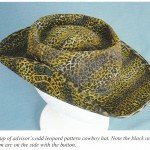
-
American advisor cowboy hat in Vietnam (1959) Courtesy Paul W. Miraldi, Schiffer Books
-
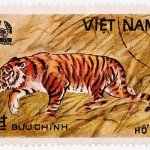
-
Panthera tigris, courtesy Ivan Vdovin
-
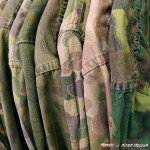
-
Camo coma at MF® (2015)
For the past 100 years or so, commercial or military camouflage has continued to appear in all kinds of shapes, colors, forms, at various levels of justification. See the “Disruptive Pattern Material” brick (ISBN-13: 978-1554070114) for a potential camo coma.
In the printed camouflage family, the military ‘Experimental’ group is of particular interest to me. It features patterns painstakingly designed by boards of experts that never made it to standard issue status, from either lack of interest, failure of the field tests, budget issues, fluctuations in theater of deployment according to where the evil enemy of the month hides, etc…
Specimens of obscure patterns are sporadically unearthed and sometimes shared by collectors, such as this handsome “MacLaren” for instance. Some patterns are only known to be in existence from a brief feature on an official publication or rare field test photo set. Whether one-of-a-kind individually hand-painted for a specific mission, or produced in small batch/tested in combat/pulled as inconclusive, there’s gotta be some interesting stories about these experimental camouflage pattern in the Fort Belvoir archives (US military’s headquarters for camouflage R&D in Virginia), or the Natick Labs file cabinets…
-

-
Soldier-Artist sketching at Fort Belvoir (1942)
-
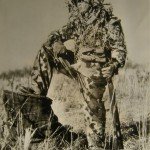
-
Experimental MacLaren Camo (1943)
-
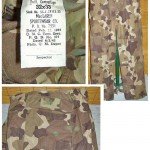
-
MacLaren Camo (1944) Courtesy US Militaria Forum (Hzamar)
-
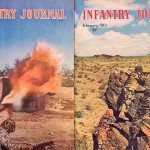
-
Infantry Journal (1944) featuring Exp Camo
-
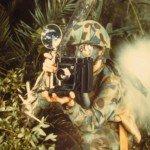
-
Combat Photographer WW2
-
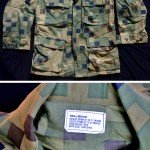
-
Experimental Camo (1970s)
In an effort by the Clothing Division of the Office of the Military Planning Division to financially recover part of the cost of R&D, it is plausible to imagine that rolls of obsolete experimental camouflage fabric ended up being sold to jobbers or Army/Navy surplus stores, eventually cut & sewn into tarps, hunting clothes and civvy fatigues. Obscure sample runs and seconds from the stock pile of a fabric-printing mil-specs contractor could also surface out of nowhere after liquidation…
For the Mister Freedom® Spring 2015 “Saigon Cowboy” collection, I thought of temporarily playing camoufleur. But how does one ‘invent’ a camouflage? Relieved of the overwhelming pressure of having to help save or take lives, I was still shooting for something that would look more legit than foofoo. Besides the early realization that most assignments are better left to professionals, off we were on our merry way to come up with the first ever ‘original’ MF® ‘flage! Oh boy…
As most camouflage patterns are an interpretation of a predecessor (the 1980’s Woodland is an evolution of the 1960’s ERDL leaf pattern), I felt less shame borrowing the famous amoeba shapes of the P1942 “Frog Skin” we had used for the Map Shirt of our Sea Hunt days . We opted for the same sturdy 100% cotton HBT white base fabric however, the same painstaking rotary-print technique (not computer printed or over-dyed), and the same concept of a reversible fabric.
The fun part was selecting the colors… and determining where exactly the MacLaren-inspired sparse lime green amoebas looked best.
After going back for weeeeeks to the drafting table, with color swatches and unsatisfying protos, going bananas and obsessing about visual contrasts & blends, face & reverse, we managed to settle on ONE pattern, in several options.
If our approach is an obvious nod to the Beach & Jungle sides of 40’s USMC reversible Frog Skin gear, the MF® Exp. camo combines camouflage with a simple solid side. The solid side cachou color is a reference to the caramel-like color typical of 1930’s French military canvas gear. Please note that if our fabric is technically reversible, the resulting garments are not.
For confusion sake, and to make sure everyone feels as in-the-fog as we do, here is a list of MF® Experimental ‘flage options available this season (please note that, depending on distribution in a specific Country, not all options are available). The face/reverse options are:
A) LoLand out (jungle, darker)/cachou in.
B) HiLand out (arid terrain, lighter)/cachou in.
C) Cachou out/HiLand in.
Wearing an early proto jacket of the MF® LoLand camo the other day at the Rosebowl flea market, it was quite satisfying to be asked by a puzzled seasoned militaria collector “What Country is that?”… Made my day.
The MF® Exp. camo is featured on two pieces of our “Saigon Cowboy” Spring 2015 collection.
* The Evac Jak.
* The Utes.
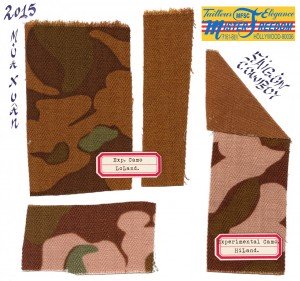 MF® Experimental Camouflage Spring 2015
First to hit the LZ this season is the “Evac Jak”, a snap closure cotton jacket.
For the inclined, a bit of approximative History and semantics follows. Read or fast-forward, but as always make sure not to quote me on anything that requires exactitude…
The name we picked is a reference to MEDEVAC, the call sign for helicopter ambulance and crew in charge of medical evacuation during the Vietnam conflict. For the 1st CAV who forged its own, a MEDEVAC crew consisted of an Aircraft Commander, Co-Pilot, Crew Chief, Door Gunner and a Medic. Defying the odds of survival by most likely landing in a hot zone, these men gave their lives to save others’. Statistics have it that, among the ranks of American soldiers fighting in Vietnam, “nearly 98% of those wounded in action were evacuated from the battlefield alive.”
That courage qualified the dustoff crews as a trooper’s best friend on the battlefield. For the wounded soldier, the sound of that Huey coming to the rescue was sweet & sour music, the sight of that flying Red Cross meant a ticket back ‘in the world’.
In a war that dragged over a decade, in-the-field gallantry could only be sustained by the relative reassurance of knowing someone was coming to lift you out of the muck on time. Countless accounts of courage and sacrifices from those MEDEVAC and DUSTOFF crews have been published.
Similarly, the NVA (=the communist North Vietnamese Army, China’s protégé opposing the South Vietnamese Army, aka ARVN, America’s protégé… just look it up) went through great length to carry their fallen away from the battlefield for proper burial ceremonies. Faced with fighting the most powerful Nation on Earth, NVA and VC troops needed the guarantee of a better afterlife to accomplish the impossible…
-
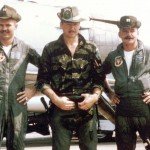
-
USAF pilots Bruce Holmes, Will Koenitzer, William Barthelmas (circa 1965)
-
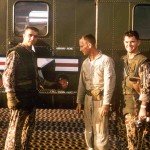
-
Vietnam Marine Squadron (1963) Courtesy Jack Ubel
-
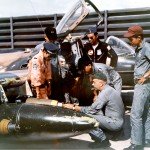
-
VNAF pilots and USAF instructor (1960s)
Back to our fiction…
Because a specific helo pilot-issued jacket didn’t seem to happen during the Vietnam conflict, we decided to come up with one. The style of our “Saigon Cowboy” Evac Jak is inspired by 1960’s US Air Force flight suits, 1950’s French army field jackets and Vietnam era flyboy gear, with an in country-made flair. Pilots and flight crews occasionally had custom local-made gear to replace the standard Gov’t issued garb, as period photography hints. Camouflage appealed to some airmen, should they themselves get to experience waiting for a dustoff… The one-piece flight suit also proved unpractical and some pilots, fixed wing or rotary, opted for the jacket (shirt)/pants combo.
To accentuate the local-made meets custom Saigon tailor ‘vibe’, we have ink-stamped sizing in a manner reminiscent of CISO-supplied military garments. The “US” stood for sizing following American standards, as opposed to the “A” stamp differentiating Asian standards garments. See the book “Tiger Patterns” (ISBN-10: 0764307568) for more on that.
For the anecdote-oriented few, the idea behind our MF® “mfsc Tailleur” woven label being somewhat concealed on this jacket (bottom of the inside front panel, and not in its expected back yoke position), is to highlight the contrast between name-branding and the signature of a local tailor. Oddly enough, in the past, legit tailors tended to sign their works in a conspicuous spot. Famous Brands today do it on the outside, with voluminous logos.
The Evac Jak is designed in California by Mister Freedom® and manufactured in Japan by Sugar Cane Co.
SPECS
FABRIC:
Somewhat original Mister Freedom® camo pattern, double-side rotary screen printed (one side solid, one side camo), white 100% cotton Herringbone Twill (HBT) fabric base.
Fabric milled and printed in Japan.
DETAILS:
* Inspired by vintage USAF flight suits and French military field jackets.
* Un-lined, no overlock seams.
* ‘Bat sleeves’ arm pattern.
* Flight suit typical slanted chest pockets with mil-specs replica 1950’s US Air Force metal “CROWN” zippers.
* Large lower cargo-type pocket.
* Concealed snap front closure.
* Arm pen pockets.
* Wrist snap cinch tabs.
* Round collar with removable chin-strap
* Underarm mesh screen eyelets.
* Intricate front/rear shoulder yoke.
* Flat felled seam construction, 100% cotton thread.
* Non-reversible.
* Made in Japan.
SIZING/FIT
This garment comes raw/unwashed and will shrink to tagged size after an original cold soak/line dry. Further shrinkage to be expected with the use of hot water and heat dryer.
All MF® Exp. Camo fabric options will shrink the same.
If you are a Medium (38) in mfsc jackets, you are a Medium in the Evac Jak.
Please refer to sizing chart for measurements reflecting a 30mn cold soak no agitation/light machine dry.
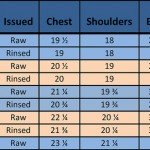
CARE:
Launder when hygiene dictates and common sense prevails.
Machine wash. Cold water, gentle cycle, eco-friendly mild detergent and line dry. We recommend turning garments inside out to avoid marbling of the fabric during the washing cycles.
Because the base HBT fabric is white before being printed, toning down of colors will naturally occur. This fading should not be considered a quest nor a defect, only the natural consequence of the wash/wear process over the years.
Available RAW/unwashed
SIZES:
Small
Medium
Large
X-Large
XX-Large
RETAIL $429.95
Available from www.misterfreedom.com, fine retailers around the World, and our dusty Los Angeles brick & mortar store.
Email sales@misterfreedom.com or call 323-653-2014 with any questions unanswered above, like what happened to D) Cachou out/LoLand in???!
Thank you for your support
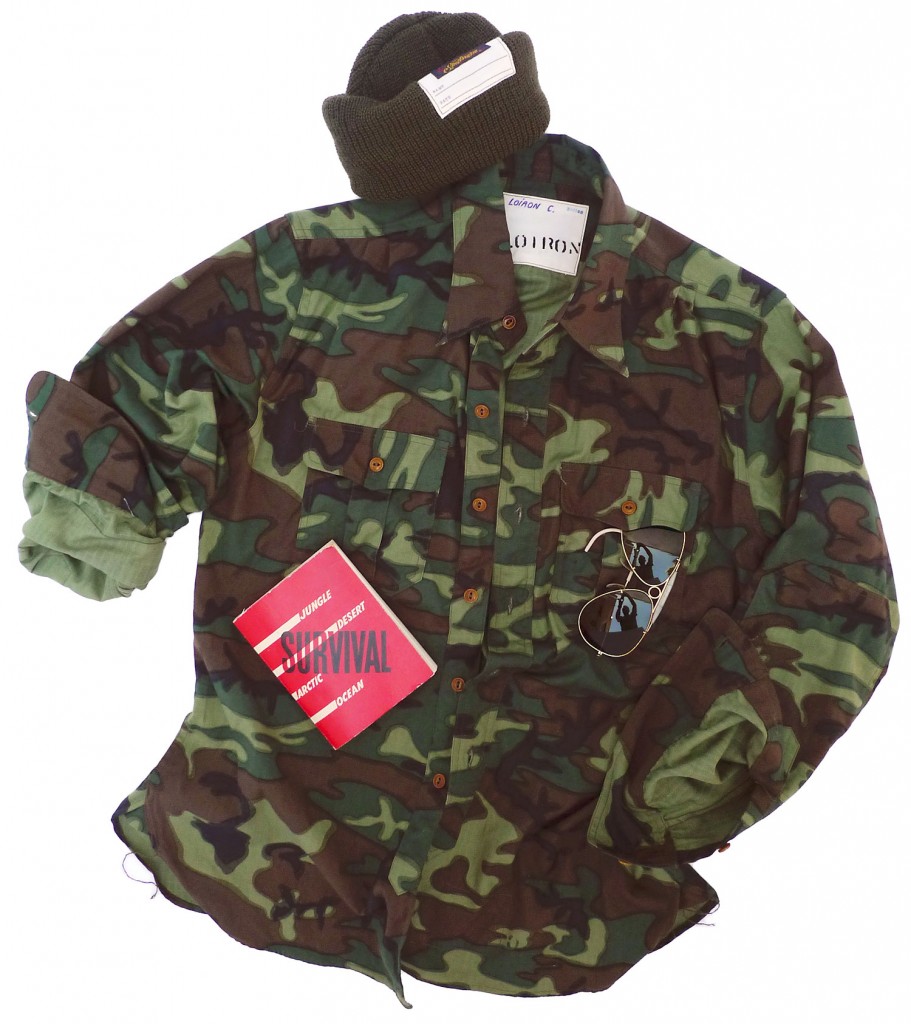
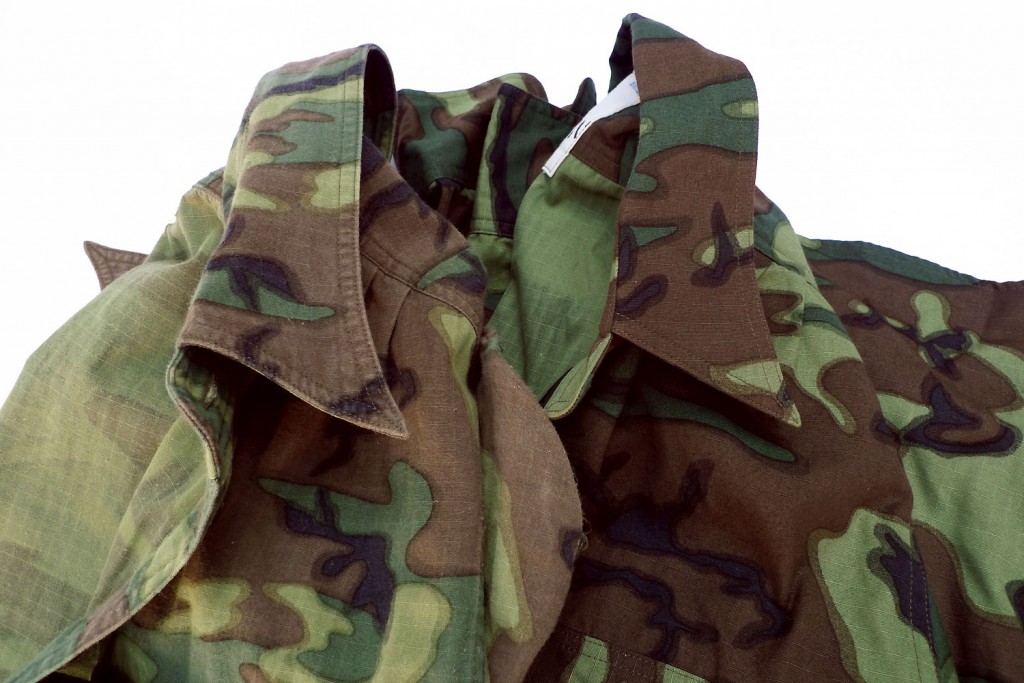 Well worn and washed vs. raw
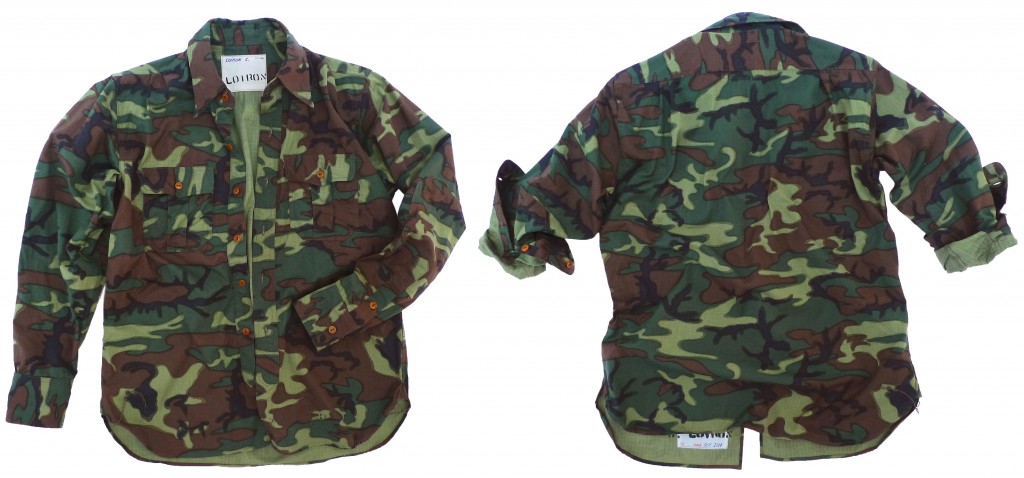
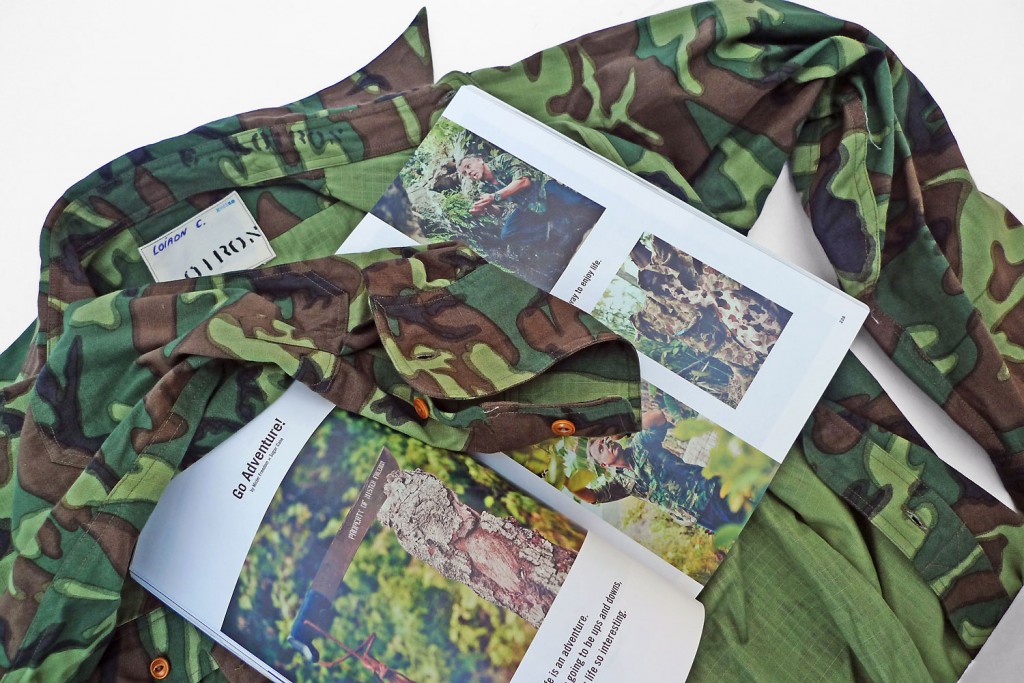 Clutch Magazine, Vol.22, November 2014. Please note that these are GREAT quotes, but NOT my quotes.
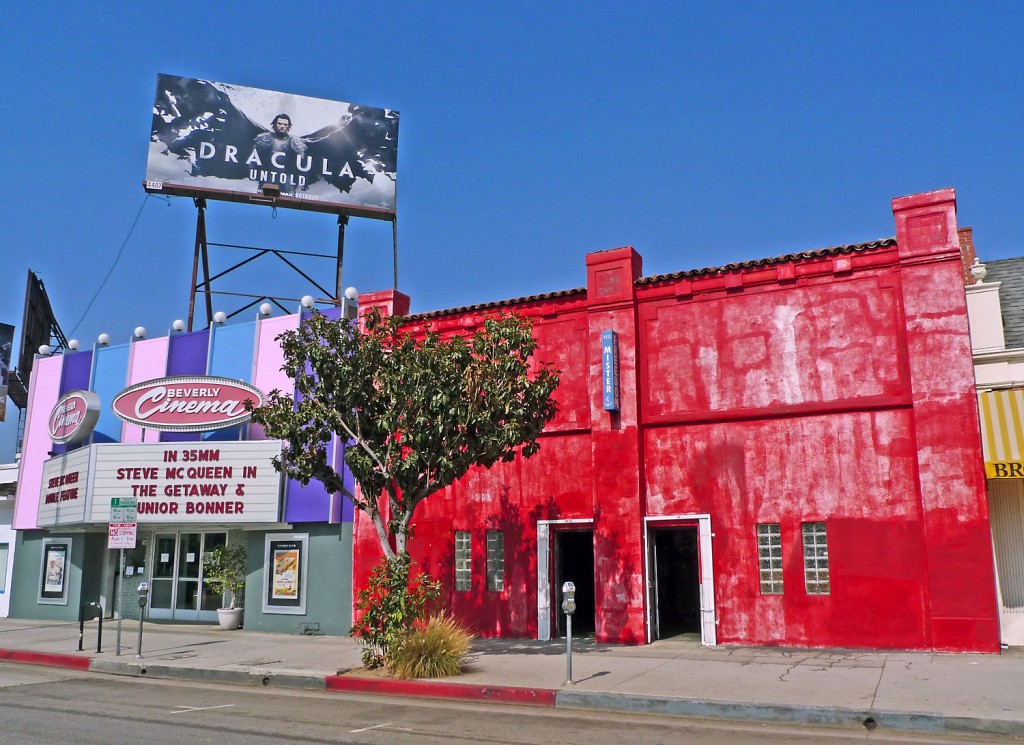 Just for a touch of color
ERDL Patrol Shirt
“Sea Hunt” mfsc collection Fall 2014
We are adding another option to our Patrol Shirt grouping. After introducing the arctic white, jungle green, USN-type chambray during the “Sea Hunt” Spring 2014 chapter, here is a camouflage number.
You are correct, there is also a blue one.
In the genuine camo family, “Lowland ERDL” is one that always caught my eyes, long before I knew its name. When rummaging through piles of military clothing in my raghouse-picking days, I seemed to consistently be drawn to its specific pattern/color combo.
Drawing attention is probably not what John Hopkins, chief designer of camouflage at the “Engineer Research & Development Laboratories” of Fort Belvoir, Virginia, had in mind when he designed the ‘leaf pattern’ in 1948…
This artistic attempt at blending in with nature was further developed at the US Army Natick Soldier Center by a team of experts led by scientist Alvin O Ramsley. (The brave few who submit themselves to these write-ups will note that we had already mentioned that legendary facility in a previous post, when introducing our Skipper Jackets.)
Subsequent testing and adapting of the still un-issued ‘leaf pattern’ lead to an official camouflage pattern referred to as ERDL. By 1967, it was optimized for the Vietnamese terrain.
A lime-dominant “Lowland” version was issued to US elite troops for their vacations in Southeast Asian jungles. Followed a brown-dominant “Highland” version (a tan color replacing the lime green), better suited for arid mountainous areas of the ski resort-type.
Within original vintage ERDL Vietnam-era fatigues, one will find quite a few variations of technically the same thing. My favorite tropical camies are those combining panels of both lowland and highland shades, the finest hours of the contractor QC department.
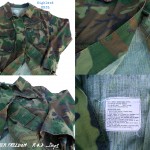
ERDL stayed a US Gov’t issue until 1981, when it eventually morphed into the ‘Woodland‘ pattern that replaced it.
When stealth became a part of specific jungle missions for our “Sea Hunt” team, ‘Lowland ERDL’ had plenty street cred and was quickly adopted. Such a mission has been captured on camera and some rare images can be seen in the November 2014 issue of Japanese CLUTCH Magazine. Viewer discretion is advised however, as the sheer thrill and daredevil requisites of that cliffhanger of an assignment are palpable on the photos, and could prove quite disturbing for some. Haunting stuff. You have been warned my friend. That six-page magazine spread is also punctuated by quotes I wish I had come up with, such as “Go adventure!”…
I did manage to p*** off a black rattlesnake with my walking stick, but that’s the one thing that is not on film.
Anyways, back to our design studio and the R&D phase. The original vintage sample we used to develop our interpretation of this classic camouflage is an authentic 1969-issued ‘Lowland ERDL’ bush hat found in ‘New Old Stock’ condition, still in its original clear plastic packaging. Until recently, an old Army/Navy surplus store in Oxnard, California, still had some of these sitting on its shelves…
As mentioned when introducing the P1942 Frog Skin camouflage fabric of our Map Shirt, the printing process for our ERDL fabric is complex, not computer-generated.
The base fabric, a 100% cotton ripstop popeline is originally stark white. Through rotary screen printing techniques, four colors in the distinctive ‘leaf pattern’ are applied to the face of the fabric, lime green/forest green/brown/black, with almost no bleed-though. The reverse of the fabric gets a solid lime green coat of ink.
If our colors were closely matched to those of the NOS bush hat, several other vintage ERDL samples were provided to the printing factory to instruct the ink experts on how we wanted our fabric to evolve overtime. Just as its original forefathers, our ERDL printed fabric will naturally fade.
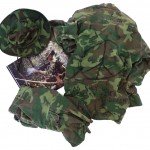 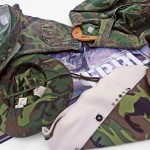
For those into the historical background of man-made camouflage, and fortunate to get their hand on a copy of the book, fascinating information can be found in Hardy Blechman’s “Disruptive Pattern Material” study.
Yet another fascinating book is the one displayed in the vintage ERDL gear shots above. It is the Vol.1 limited edition of “LRPP, Long Range Reconnaissance Patrol photos“, the works of Jay Borman. Thanks to Cory Piehowicz for the reference.
In terms of style, our Patrol Shirt is inspired by several vintage shirts from our archives, and is by no means a replica of Vietnam-era GI gear.
Throwing military/safari/uniform details in the MF® blender, the resulting garment is an apparently simple looking shirt. It features some fancy details however, most of which only the wearer will notice. This is not why people will stare at you while wearing this shirt, but take a look at the bottom of the button placket, on the inside, for some interesting folds and challenging pattern making magic.
Like its Spring 2014 predecessors, our ERDL Patrol Shirt features the usual elbow patches, box-pleat pockets, expansion ease-pleats, side gussets, rounded wrist cuffs…
The ERDL Patrol Shirt is designed in California by Mister Freedom® and manufactured in Japan in collaboration with Sugar Cane Co. Fabric milled and printed in Japan.
SPECS:
FABRIC:
100% cotton ripstop popeline, 4.75 oz., silkscreened with vintage 1960’s ERDL camouflage pattern.
Milled and printed in Japan.
DETAILS:
* All original mfsc pattern, inspired by vintage military, uniform and safari type shirting.
* Two box-pleat chest pockets, buttoned flap.
* Attractive 1940’s-style collar pattern.
* Early tailor-made custom uniform button placket.
* Elbow reinforcement patches.
* Side gussets.
* Double front & back expansion EZ-pleats on shoulder yoke.
* Corozo buttons, aka ‘ivory nut’, 100% wood, golden brown color.
* High stitch count 100% cotton tonal stitching.
* Vintage ½ cm wide flat-felled seam side construction.
* Double inside labeling: simple ‘minimalist’ neck patch (unbleached popeline stamped with sizing), and woven ‘Sea Hunt’ rayon label on bottom front panel (inside). Both to accommodate your own custom markings, if desired.
* Made in Japan
WASHING/SIZING:
This shirt comes raw/unwashed and will shrink to tagged size.
We recommend an original cold soak, spin dry and line dry.
Further care should be the low maintenance combo mild detergent/gentle cycle/cold water/line dry, as needed.
I wear a Medium in mfsc shirts and am a Medium in the ERDL patrol shirt.
Please refer to chart for cold rinse/line dry measurements.
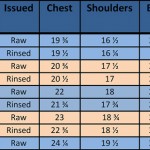
Available RAW/unwashed.
SIZES:
Small
Medium
Large
X-Large
XX-Large
Retail $329.95
Available from www.misterfreedom.com
Please call 323-653-2014 or email sales@misterfreedom.com with any questions not answered above.
Thank you sincerely for your support.
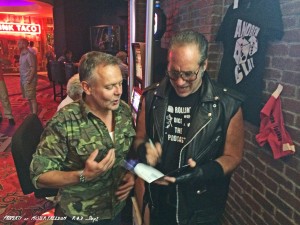 Field testing. Ooooh
|

























